Powell River Project - Restoring the Value of Forests on Reclaimed Mined Land
ID
460-138
EXPERT REVIEWED
Introduction
The central Appalachian region of eastern Kentucky, West Virginia, and southwestern Virginia is gifted with abundant and commercially valuable natural resources – especially timber and coal. A huge amount of virgin timber was cut and marketed during the late 19th and early 20th centuries. Toward the end of this virgin timber harvest, coal mining became the region’s economic mainstay. After the virgin timber cut, the Appalachian forest grew again as a sustainable, renewable, and economic resource. The annual value of the timber and wood-products industry is $7.7 billion in Virginia, $23 billion for the central Appalachian coalfield states (table 1), and $46 billion for states comprising the Appalachian region as it extends northward to Pennsylvania and Ohio. Today, coal and timber – natural resources produced in central Appalachia – make significant contributions to the regional economy.
| Forestry and wood product | Ky. | Tenn. | Va. | W.V. |
|---|---|---|---|---|
| Percent of land forested | 50 | 55 | 63 | 79 |
| Total timberland (millions of acres) | 12.3 | 13.9 | 15.4 | 11.9 |
| Forest industry employment (thousands) | 26.3 | 39.7 | 35.7 | 11.5 |
| Annual payroll ($ millions) | $1,160 | $2,255 | $1,720 | $430 |
| Value of industry wood and paper shipments ($ billions) | $6.3 | $7.2 | $7.7 | $1.8 |
Source: American Forest and Paper Association (2006) and Virginia Tech Department of Forestry.
Reforestation of land that has been surface mined for coal can produce high-value commercial forests while providing watershed protection and wildlife habitat. Prior to the 1977 Surface Mining Control and Reclamation Act (SMCRA), most surface-mined land in the East and Midwest was reclaimed with trees. These reclaimed lands varied in their quality and productivity, but reforestation was often successful and commercially valuable forests were created. Many of these new forests are maturing (Rodrigue and Burger 2004) and are providing landowners with revenue.
In the early years of the SMCRA, few forests were being restored, although the amount varied by state. Thousands of acres of Appalachian mined land that were originally forested have been reclaimed as hayland, pasture, or wildlife habitat. Such land is usually left unmanaged after bond release, and it slowly succumbs to brushy, woody vegetation with little or no commercial value. Even in states such as Virginia – where reclamation to forestry has been encouraged since the 1990s – much of the mined land that was restored to forest was planted with low-value, noncommercial species, because the spoil grading and revegetation practices of that time created conditions that were hostile to tree survival. Therefore, mining firms planted species such as black locust and pines that had a better chance of surviving than the more sensitive native hardwoods, such as the oaks. Eastern white pine is the one commercial species that was widely planted during those years, but its growth was often hindered by poor soil properties. An Appalachian Regional Reforestation Initiative (ARRI) publication, Forest Reclamation Advisory No. 1, whose lead author is with the U.S. Office of Surface Mining (see references), describes the historical context and the reasons why these reclamation practices were widespread.
Today, that picture is changing as mining firms in Virginia and elsewhere in Appalachia are adopting a new reclamation method called the Forestry Reclamation Approach (FRA) (see How to Restore Forests on Surface-Mined Land, Virginia Cooperative Extension [VCE] publication 460-123; and The Forestry Reclamation Approach, ARRI Forest Reclamation Advisory No. 2). When mined land is restored to productive forests, landowners can enjoy the economic benefits of commercial forestland while creating land that supports wildlife habitat, watershed protection, and similar environmental values that benefit the public. The purpose of this bulletin is to provide information that will aid landowners in estimating the effects of reclamation practices on forestland values, while emphasizing that creating productive mine soils for native trees can be accomplished at no additional cost to the mine operator.
Reclamation to Produce High-Quality Forest Soil
Research by reclamation forestry groups throughout the Appalachian and Midwestern coalfields has shown that productive mine soils and forests can be restored by using the five steps of the Forestry Reclamation Approach (FRA):
- Create a suitable rooting medium for good tree growth that is no less than 4 feet deep and comprised of topsoil, weathered sandstone, and/or the best available material.
- Loosely grade the topsoil or topsoil substitute, established in step 1, to create an uncompacted growth medium.
- Use groundcovers, when required, that are compatible with growing trees.
- Plant two types of trees: early successional species for wildlife and soil stability (no more than 20 percent of total stocking), and commercially valuable crop trees (80 percent or more of total stocking).
- Use proper tree-planting techniques and good planting stock.
The FRA method has been used successfully by many coal-mining firms. It is described with some detail in ARRI Forest Reclamation Advisory No. 2; VCE publication 460-123; and Establishing Groundcover for Forested Postmining Land, VCE publication 460-124. Using the FRA can save the mine operator hundreds of dollars per acre compared to traditional reforestation practices due to reduced grading costs and less expensive groundcover seed mixtures.
Recent experience by mining operators indicates that two to four hours of unnecessary grading per acre can be avoided when loose-grading practices, consistent with FRA practices (see ARRI Forest Reclamation Advisory No. 3), are used as an alternative to traditional smooth grading that covers the surface with dozer cleat marks (“tracking in”). If ownership, operating, and maintenance costs for a dozer are $200 per hour, the result is a cost savings of $400 to $800 per acre for the mining operator.
Additional cost savings can be realized by replacing the traditional revegetation practices, which use fast-growing grasses, with “tree-compatible” revegetation that uses less seed and fertilizer. Although planting hardwood seedlings costs the mining operator more than the pines, black locust, and other lower-value species that were commonly used prior to the FRA method, this expense is offset by the cost savings from reduced grading and revegetation.
The Forestry Reclamation Approach is consistent with SMCRA regulations at the federal level, in Virginia (see Forestry Reclamation Approach, Virginia Division of Mined Land Reclamation Guidance Memorandum 22-08), and in other eastern states (see ARRI Forest Reclamation Advisories Nos. 1 and 2).
Minesoil Quality Measured by Site Index
Reclaiming mined land for forestry is compelling because the productivity of forests and the value of wood produced on reclaimed lands after mining can be greater than prior to mining – but only if FRA or comparable reclamation practices are used. Instead of agricultural productivity measures such as bushels per acre or tons per acre, foresters judge minesoil quality based on the average height of trees at a given age, such as age 25 or 50 years. Tree height can vary greatly at the same tree age due to minesoil and mine-site quality. This height comparison at a selected age (age 25 for conifers and age 50 for hardwoods) is commonly used to “index” the soil, site, or land potential for forestry and is referred to as the “site index” (SI). As illustrated in figure 1, trees grow slowly on poor-quality mine sites and are relatively short by age 25 (SI = 45 feet) compared to trees of the same age on average minesoil quality (SI = 55 feet) or trees of the same age on good minesoil quality (SI = 70 feet).
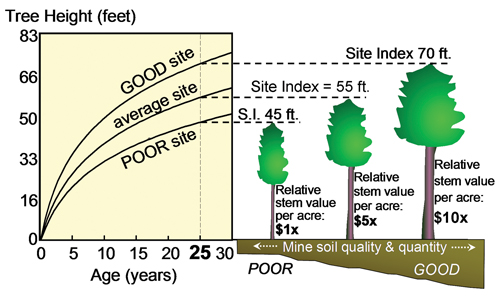
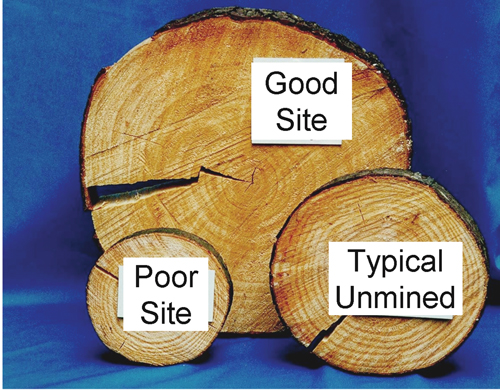
To illustrate how site quality affects timber value, two examples using timber species that are commonly planted on reclaimed mine sites follow.
1. Effect of Site Index on Timber Value: White Pine
Research data can be used to demonstrate the effects of reclamation technique on white pine productivity and stand value at age 30 (table 2). For perspective and reference, case I shows the estimated value of an average 30-year-old white pine stand growing on undisturbed soil in the Appalachians. Average site quality measured by site index (height at age 25) is 55. Under typical management, at the harvestable age of 30 eastern white pines growing on site index 55 will produce about 28,000 board feet per acre as small sawtimber. That wood will be worth an estimated value of $1,400 per acre “on the stump,” based on average prices in the central Appalachian region over the 10-year period of 1999-2009.
| Case # | White pine site type | Site indexa (feet) | Timber volume (MBF/ acre)b |
Harvestable wood products | Harvest price ($/ MBF)\c |
Total value ($/acre) |
|---|---|---|---|---|---|---|
| I | Average quality of an undisturbed Appalachian forest site (Doolittle 1958) | 55 | 28 | small sawtimber | $50 | $1,400 |
| II | Average quality of a post-SMCRA, non-FRA minesoil | 45 | 5 | pulp | $20 | $100 |
| III | Actual quality of a white pine stand on a good minesoil in Virginia (Kelting, Siegel, and Burger 1997) | 70 | 37 | large sawtimber | $75 | $2,800 |
a Site index = expected eastern white pine height after 25 years, in feet.
b Harvestable timber volume at age 30, expressed as thousands of board feet per acre (MBF/acre), based on yield tables prepared by Vimmerstedt (1962).
c Harvest price, estimated as an average of what was typical over the 1999-2009 period. Actual harvest prices vary with market conditions.
Based on our research on 78 mined sites in Virginia, Kentucky, and West Virginia that were reclaimed using conventional, pre-FRA procedures, we estimate that forest-site quality was reduced to an average value of site index 45 (table 2, case II) (Andrews et al. 1998). The productive capacity is greatly reduced compared to premining conditions and the total value of timber growing on the mine site will be just a fraction of its original potential – $100 per acre in this example – compared to $1,400 per acre for a white pine stand of equivalent age and density on typical natural soil prior to mining.
Case III represents data from a site that was mined and planted to white pine (see figure 3), which was 17 years old when measured for site index in 1997. Minesoil and groundcover conditions at the time of planting were similar to those that occur when the FRA is used. The measured site quality is 70, and the projected volume at a harvest age of 30 is 37,000 board feet per acre. Due to the higher value of large sawtimber, the value would be $2,800 per acre. These data show that mined land, when properly reclaimed, can be very productive. Because minesoils are deeper than those that occur on mountain slopes prior to mining, the minesoils can be more productive for forest products than the premining soils if appropriate reclamation techniques are used. Furthermore, the value of wood products is disproportionately higher on better-quality sites because large timber is worth more than small timber. To say it more academically: the dollar value increases exponentially with site quality.
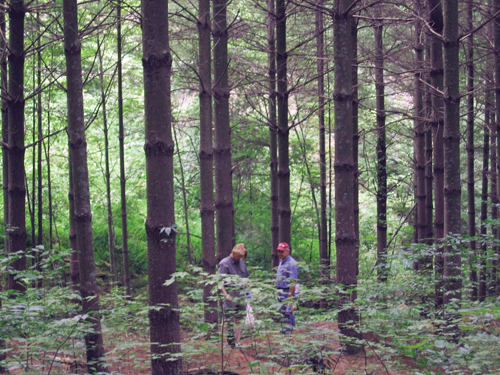
2. Effect of Site Index on Timber Value: Red and White Oak
White pine was used in the analysis above because of its predominant use on post-SMCRA mined land through the mid-2000s. Although total wood volume would be less for hardwoods, the same general relationship between site quality and value per acre would hold true. Because eastern white pine is sensitive to soil properties, we can use its known productivity to estimate comparable productivities for oaks on minesoils. A site with a white pine SI of 55 (age 25) can be expected to have an oak SI of 65 (age 50), which is an average value for oaks across most of the Appalachians. This species-to-species relationship shows that average post-SMCRA, but pre-FRA, site quality for oaks would be about SI 50, and the site quality potential for oaks of FRA-reclaimed mine sites would be about SI 85. This estimate is confirmed by Ashby et al. (1984) who evaluated minesoil productivities for oak species.
Table 3 shows the relative influence of soil and site properties on oak site index, wood yield, and harvest value, as we expect it to be affected by reclamation practices. Average oak sawtimber value at age 60 on average quality sites (SI = 65) is about $3,400 per acre under average management. If forest sites are degraded from SI 65 to SI 50 by the non-FRA practices that were commonly used through the mid-2000s, potential harvest value becomes one-fourth of what it was originally. If sites are upgraded to SI 85 by using the FRA, harvest values double when compared to the premining conditions and are more than five times the value of what could be expected of oaks that are planted on a non-FRA mine site (figure 4). In reality, the total value of oaks growing on the non-FRA mine site (case I, below) may be overestimated because reclamation practices affect tree survival as well as growth, while the yield tables upon which these figures are based assume fully stocked timber stands.
| Case # | Oak site type | Site index (feet)a | Timber volume (MBF/ acre)b | Harvestable wood products | Harvest price ($/MBF)c | Total value ($/acre) |
|---|---|---|---|---|---|---|
| I | Average undisturbed Appalachian forest site | 65 | 9.4 | sawtimber | $360 | $3,400 |
| II | Average quality of a post-SMCRA, nonFRA reclaimed minesoil | 50 | 4.5 | small sawtimber | $200 | $900 |
| III | Estimated quality of a post-SMCRA reclaimed minesoil when FRA is used | 85 | 13.0 | large sawtimber, veneer | $520 | $6,800 |
a Site index = expected red or white oak height after 50 years, in feet.
b Harvestable timber volume at age 60, expressed as thousands of board feet per acre (MBF/acre), based on yield tables prepared by Schnur (1937).
c Harvest price, estimated as an average of what was typical over the 1999-2009 period. Actual harvest prices vary with market conditions.
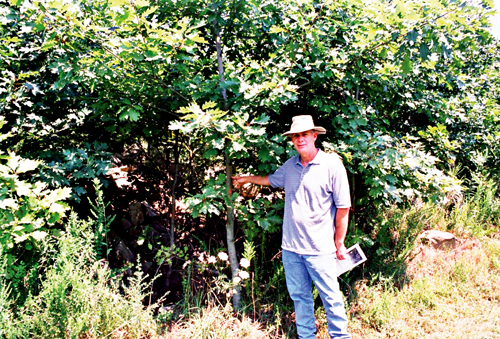
Both of the examples above show the dramatic effect that site quality has on forestland value and why landowners and the mining community should strive for proper reclamation of forestland (figure 5).
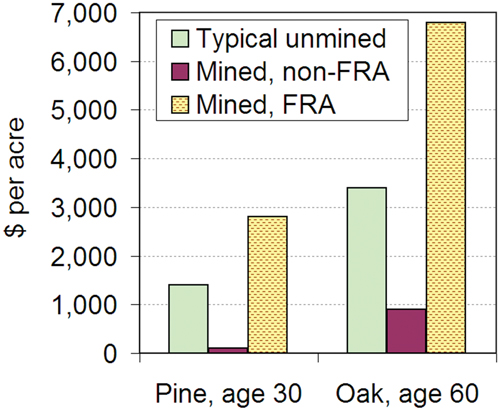
Other Values of Mined Land Reforestation
Tax treatment in some states may be a further short-term incentive for landowners to choose productive forestry postmining land use. In West Virginia, for example, the Managed Timberland Tax Incentive Act provides for taxation based on timber capability class. If a landowner’s timber capability was good to average before mining, but poor after mining, the owner must pay a postmining tax rate based on the premining productivity, which can be higher than the postmining land can support.
Another reason for coal operators to promote forestry as a postmining land use is to enhance relationships with their business partners – resource owners and coal-burning electric power producers. Resource owners that control both mineral and surface have an economic interest in maintaining the forest productivity of land mined for coal. Thus, mining firms that can demonstrate the capability to restore or enhance premining forest productivity through FRA can cite that capability in coal leasing contract negotiations with mineral owners that retain surface interest.
If carbon-emission restrictions become law at a future time, it is likely that coal-burning, electric power producers will be called upon to offset carbon emissions to the atmosphere. Today, much of the surface mining in central Appalachia occurs on sites that include some previously mined land where forests were not restored. If the power producers can purchase coal from mines that increase the land’s carbon-storage potential through reforestation in order to help meet their carbon-emission offset requirements, coal producers with excellent reforestation programs will have a marketing advantage. Planting trees on productive minesoil after mining is a way to produce a measurable carbon sink (Amichev, Burger, and Rodrigue 2008). Forests growing on good quality mine sites can sequester three to five times more carbon than grassland. Similar to the wood volume increases with productivity shown in figure 1 and tables 2 and 3, sequestered carbon increases exponentially with mine-site quality, with average values of 0.5 tons per acre per year for poor sites, 1 ton per acre per year for fair sites, and 2 tons per acre per year for good sites.
Society at large also benefits from mine reclamation practices that restore productive forests. In addition to establishing commercially valuable trees that sequester atmospheric carbon, the Forestry Reclamation Approach allows return of the full forest community through ecosystem succession processes (see ARRI Forest Reclamation Advisory No. 5). Such forests stabilize minesoils, maintain clean water in rivers and streams that drain coal-mining areas, provide watershed protection services such as reduction of the peak flows that can cause flooding, enhance wildlife habitat, and improve landscape aesthetics.
The coal industry can benefit from more widespread use of reclamation practices – such as the Forestry Reclamation Approach – that restore native forests. Public perceptions of coal and coal mining in many areas of the United States are negative, because many among the general public believe that mining destroys the land’s biological capacity. More widespread and successful application of the Forestry Reclamation Approach by the coal industry can help to counteract such perceptions by demonstrating the industry’s capability to restore and enhance mined land’s biological capability, as is required by SMCRA.
Conclusion
Proper reclamation and reforestation techniques can meet the spirit of the law requiring that forestland be returned to its former use and level of productivity. The Forestry Reclamation Approach, which is becoming widely used by coal operators in Virginia and other Appalachian states, restores productive forests through reclamation of coal mine sites. Landowners, miners, and society at large benefit when improved forest reclamation techniques are employed:
Landowners benefit from a postmining timber resource of significant economic value.
Miners benefit from reduced reclamation cost, SMCRA compliance, and prompt bond release when reforestation is done properly.
Society benefits from wildlife habitat, watershed protection, carbon sequestration, and other ecosystem services, and the jobs and other economic benefits that are made possible by the valuable timber products that can be grown and harvested from reclaimed mines.
Acknowledgements
Research on which this summary article is based was funded by the Powell River Project; U.S. Department of the Interior, Office of Surface Mining Reclamation and Enforcement; U.S. Department of Energy’s National Energy Technology Laboratory; and other sponsors. Thanks to Tim Probert of Marshall Miller & Associates for his advice and assistance in estimating timber market prices for tables 2 and 3.
References
Powell River Project/Virginia Cooperative Extension Publications: Available from Powell River Project (www.cses.vt.edu/PRP/) and Virginia Cooperative Extension (www.ext.vt.edu).
Burger, J. A., and C. E. Zipper. Revised 2009. How to Restore Forests on Surface-Mined Land. VCE publication 460-123. http://pubs.ext.vt.edu/460-123.
Burger, J. S., C. E. Zipper, and J. Skousen. Revised 2009. Establishing Groundcover for Forested Postmining Land Uses. VCE publication 460-124. http://pubs.ext.vt.edu/460-124.
Appalachian Regional Reforestation Initiative (ARRI) Publications: Available from http://arri.osmre.gov/fra.html
- Forest Reclamation Advisory No. 1. The Appalachian Regional Reforestation Initiative.
- Forest Reclamation Advisory No. 2. The Forestry Reclamation Approach.
- Forest Reclamation Advisory No. 3. Low Compaction Grading to Enhance Reforestation Success on Coal Surface Mines.
- Forest Reclamation Advisory No. 5. Mine Reclamation Practices to Enhance Forest Development Through Natural Succession.
Virginia Division of Mined Land Reclamation
Virginia Department of Mines, Minerals and Energy; Division of Mined Land Reclamation. 2008. Forestry Reclamation Approach. Guidance Memorandum No. 22-08. www.dmme.virginia.gov/DMLR/docs/operatormemos.shtml.
Other References
Amichev, B. Y., J. A. Burger, and J. A. Rodrigue. 2008. Carbon sequestration by forests and soils on mined land in the Midwestern and Appalachian coalfields of the U.S. Forest Ecology and Management 256(11): 1949-59.
Andrews, J. A., J. E. Johnson, J. L. Torbert, J. A. Burger, and D. L. Kelting. 1998. Minesoil and site properties associated with early height growth of eastern white pine. Journal of Environmental Quality 27(1): 192-99.
Ashby, W. C., W. G. Vogel, C. A. Kolar, and G. R. Philo. 1984. Productivity of stony soils on strip mines. p. 31-44 in: J.D. Nichols, P.C. Brown, W.J. Granot (eds), Erosion and Productivity of Soils Containing Rock Fragments. Soil Science Society of America, Special Publication 13.
Doolittle, W. T. 1958. Site index comparisons for several forest species in the Southern Appalachians. Soil Science Society of America Journal 22:450-58.
Kelting, D. L., C. Siegel, and J. A. Burger. 1997. Value of commercial forestry as a post-mining land use. In: Proceedings, 14th Annual Meeting, American Society for Surface Mining and Reclamation, ed. J. E. Brandt, 344-48. Lexington, Ky.
Rodrigue, J. A., and J. A. Burger. 2004. Forest soil productivity of mined land in the midwestern and eastern coalfield regions. Soil Science Society of America Journal 68:833-44.
Schnur, G. L. 1937. Yield, stand, and volume tables for even-aged upland oak forests. U.S. Department of Agriculture, Technical Bulletin 560.
Vimmerstedt, J. P. 1962. Southern Appalachian White Pine Plantations: Site, Volume, and Yield. U.S. Department of Agriculture, Forestry Service, Southeastern Forestry Experimentation Station, Paper No. 149.
Virginia Cooperative Extension materials are available for public use, reprint, or citation without further permission, provided the use includes credit to the author and to Virginia Cooperative Extension, Virginia Tech, and Virginia State University.
Virginia Cooperative Extension is a partnership of Virginia Tech, Virginia State University, the U.S. Department of Agriculture (USDA), and local governments, and is an equal opportunity employer. For the full non-discrimination statement, please visit ext.vt.edu/accessibility.
Publication Date
July 27, 2023



